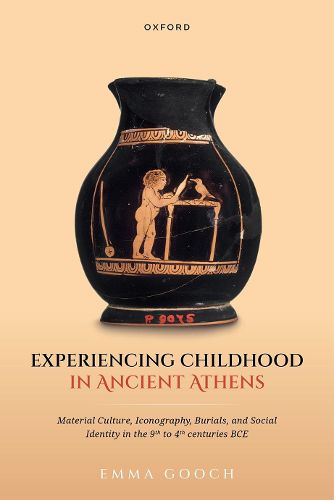Readings Newsletter
Become a Readings Member to make your shopping experience even easier.
Sign in or sign up for free!
You’re not far away from qualifying for FREE standard shipping within Australia
You’ve qualified for FREE standard shipping within Australia
The cart is loading…






Experiencing Childhood in Ancient Athens uses literary sources and archaeological and iconographic evidence to investigate children's identities throughout the ninth to fourth centuries BCE in Athens and Attica, the city's surrounding hinterland. The book presents detailed analyses of mentions of children in ancient sources, scenes showing children on Geometric, black-figure, red-figure and white-ground painted pottery, and carved marble grave markers, as well as child burials. Examples of each are thoroughly catalogued and extensively illustrated. The analyses conducted identify material cultures of children and childhood - objects used by children themselves, and objects used when caring for children - that can be used to investigate children's identities in houses and in society across the extended life course, so in life and after death. The research presented compares the range of objects associated with children at different times and in different contexts to suggest how children's identities - and how Athenian society conceptualised them and childhood - changed throughout the Geometric, Archaic and Classical periods, as the Greek polis system was established and Athenian democracy developed. The evidence considered suggests childhood became an increasingly distinct stage in the ancient Greek life course throughout the period 900 to 323 BCE but it also demonstrates that children did not necessarily became more prominent in Attic society as a consequence. It suggests that children's identities, and the symbolism of them, in many ways remained constant; with children always prized for the stability and continuity they represented but appreciated for their role in perpetuating society with increasing frequency over time and more when society was under threat. Ultimately, the author suggests major socio-political change impacted children's experiences of childhood and what it meant to be a child in ancient Athens primarily because of how it affected the agency of their family members, especially the women responsible for caring for them: warfare and political transformation concentrated in the Classical period gave women more agency to influence the range of material culture made for children, making characterisations of them in art at once more realistic and more common, even when other evidence suggests children were in fact probably less visible in society.
$9.00 standard shipping within Australia
FREE standard shipping within Australia for orders over $100.00
Express & International shipping calculated at checkout
Experiencing Childhood in Ancient Athens uses literary sources and archaeological and iconographic evidence to investigate children's identities throughout the ninth to fourth centuries BCE in Athens and Attica, the city's surrounding hinterland. The book presents detailed analyses of mentions of children in ancient sources, scenes showing children on Geometric, black-figure, red-figure and white-ground painted pottery, and carved marble grave markers, as well as child burials. Examples of each are thoroughly catalogued and extensively illustrated. The analyses conducted identify material cultures of children and childhood - objects used by children themselves, and objects used when caring for children - that can be used to investigate children's identities in houses and in society across the extended life course, so in life and after death. The research presented compares the range of objects associated with children at different times and in different contexts to suggest how children's identities - and how Athenian society conceptualised them and childhood - changed throughout the Geometric, Archaic and Classical periods, as the Greek polis system was established and Athenian democracy developed. The evidence considered suggests childhood became an increasingly distinct stage in the ancient Greek life course throughout the period 900 to 323 BCE but it also demonstrates that children did not necessarily became more prominent in Attic society as a consequence. It suggests that children's identities, and the symbolism of them, in many ways remained constant; with children always prized for the stability and continuity they represented but appreciated for their role in perpetuating society with increasing frequency over time and more when society was under threat. Ultimately, the author suggests major socio-political change impacted children's experiences of childhood and what it meant to be a child in ancient Athens primarily because of how it affected the agency of their family members, especially the women responsible for caring for them: warfare and political transformation concentrated in the Classical period gave women more agency to influence the range of material culture made for children, making characterisations of them in art at once more realistic and more common, even when other evidence suggests children were in fact probably less visible in society.